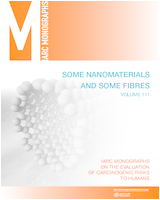NCBI Bookshelf. A service of the National Library of Medicine, National Institutes of Health.
IARC Working Group on the Evaluation of Carcinogenic Risks to Humans. Some Nanomaterials and Some Fibres. Lyon (FR): International Agency for Research on Cancer; 2017. (IARC Monographs on the Evaluation of Carcinogenic Risks to Humans, No. 111.)
Table 3.1
Induction of mesotheliomas by fluoro-edenite in Sprague-Dawley rats followed for up to 109 weeks.
Table 3.2
Induction of mesotheliomas by fluoro-edenite in Sprague-Dawley rats followed for up to 122 weeks.
Rat
Only one study, described in two reports, was conducted to examine the potential carcinogenicity of fluoro-edenite in rats (Soffritti et al., 2004; Belpoggi et al., 2011).
One group of 40 male and 40 female Sprague-Dawley rats (age, 8 weeks) received a single intraperitoneal injection of 25 mg of fibrous fluoro-edenite (the fibrous sample contained 25–30% of fluoro-edenite fibres [diameter, 0.5–1 µm; length > 10 µm] in addition to feldspars, haematite, and pyroxenes; in 1 mL of water) sampled from a quarry in Biancavilla, Sicily, Italy; a second group of 40 males and 40 females received a single intrapleural injection of 25 mg of fibrous fluoro-edenite (in 1 mL of water) through the chest wall into the pleural cavity; a third group of 15 male and 15 female rats received a single intraperitoneal injection of 25 mg of powdered prismatic fluoro-edenite; and a fourth group of 40 males and 40 females received a single intraperitoneal injection of 1 mL of water only and served as vehicle controls. [No vehicle control group for intrapleural injection was provided.] The animals were observed until all those in group 1 that were treated with fibrous fluoro-edenite by intraperitoneal injection had died (109 weeks). At 109 weeks, 70 of the 80 rats treated by intrapleural injection (group 2) had died. The average time to the appearance of tumours in group 1 was 61.6 weeks for males and 66.4 weeks for females (see Table 3.1); a total of 37 out of 40 (92.5%) [P < 0.0001, Fisher exact test] males and 29 out of 40 (72.5%) [P < 0.0001, Fisher exact test] females developed mesothelioma. The average latency for the group that received an intrapleural injection of fibrous fluoro-edenite was 71.0 weeks in males and 72.8 weeks in females; 4 out of 37 (10.8%) males and 6 out of 33 (18.2%) females developed mesothelioma. None of the rats given water or powdered prismatic fluoro-edenite intraperitoneally had developed mesothelioma at 109 weeks (Soffritti et al., 2004).
The rats in group 2 (intrapleural injection of fluoro-edenite), group 3 (intraperitoneal injection of powdered prismatic fluoro-edenite), and group 4 (intraperitoneal injection of water) were further followed for a total of 122 weeks, at which time all of the rats had died or were killed (see Table 3.2). At 122 weeks, only 1 (female) out of 80 rats that received a single intraperitoneal injection of water alone had developed mesothelioma. None of the males or females exposed to powdered prismatic fluoro-edenite developed mesothelioma, but 6 out of 40 (15%) males and 7 out of 40 (17.5%) females in group 3 (intrapleural injection of fibrous fluoro-edenite) were found to have mesothelioma (Belpoggi et al., 2011). As reported in Soffritti et al. (2004), the incidence of mesothelioma was increased in males (37 out of 40) and females (29 out of 40) that received an intraperitoneal injection of fibrous fluoro-edenite. The authors characterized the fluoro-edenite-induced mesotheliomas as epithelial, mixed, or sarcomatous. Rats given fibrous fluoro-edenite by intraperitoneal injection developed mesotheliomas of predominantly sarcomatous or mixed histology. In contrast, half of the mesotheliomas that resulted from pleural administration in males were morphologically epithelial. Many of the mesotheliomas had metastasized into the lung, lymph nodes, and throughout the abdomen. The incidence and latency were comparable with those of many types of fibre that have been demonstrated to cause mesothelioma (e.g. crocidolite and amosite) in Sprague-Dawley rats in that laboratory (Maltoni & Minardi, 1989). [The study described by Soffritti et al. (2004) and Belpoggi et al. (2011) was limited by the lack of statistical analysis and an appropriate control for the intrapleural injection experiment. However, the authors presented the mesothelioma response as a simple description to demonstrate the extent of an obvious effect. The Working Group also noted that 20 male and 20 female Sprague-Dawley rats that served as controls in a lifetime study conducted in the same laboratory (Maltoni & Minardi, 1989) did not develop mesotheliomas after a single intrapleural injection of water.]
- Cancer in Experimental Animals - Some Nanomaterials and Some FibresCancer in Experimental Animals - Some Nanomaterials and Some Fibres
Your browsing activity is empty.
Activity recording is turned off.
See more...
